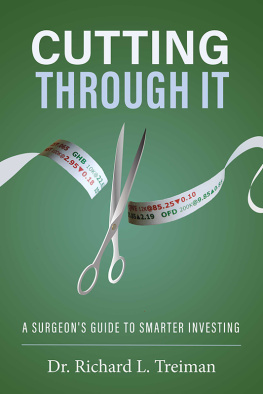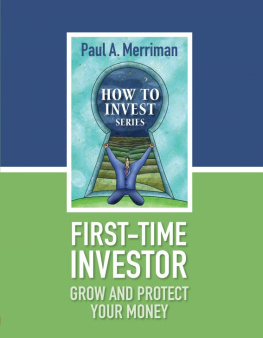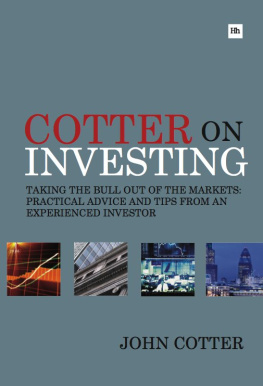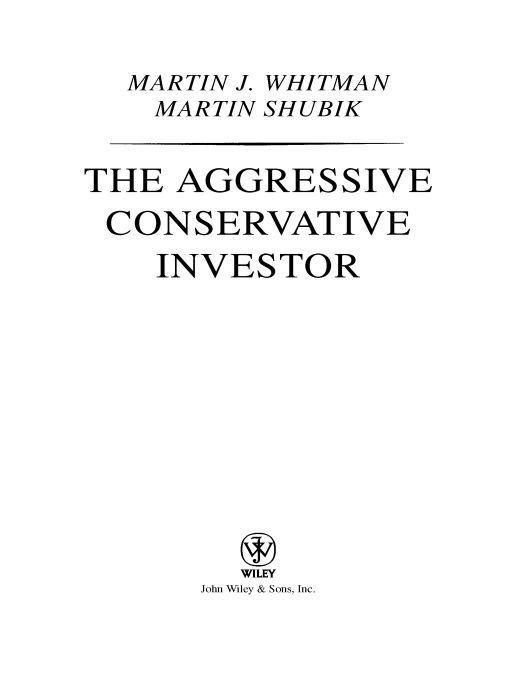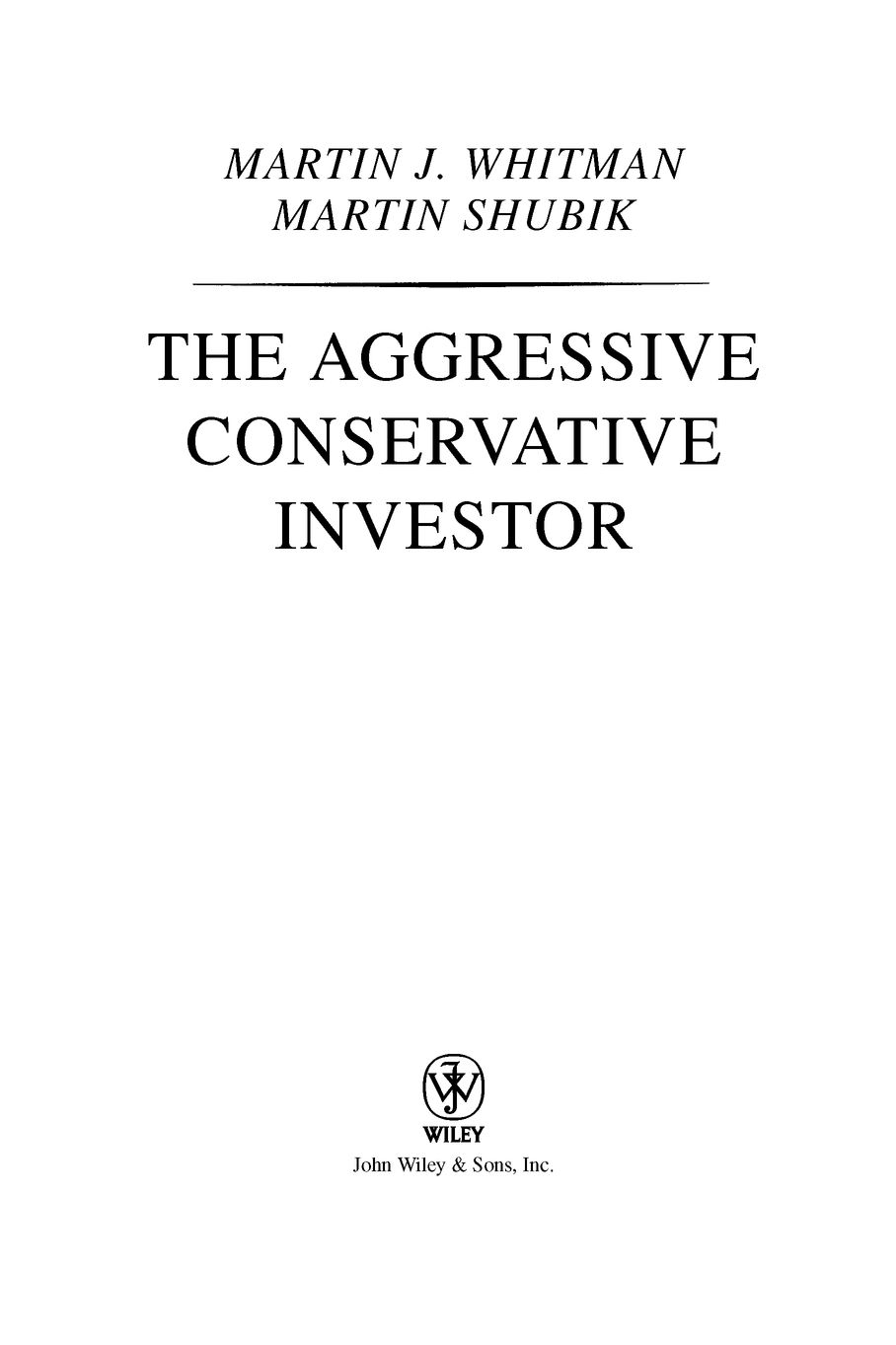Table of Contents
INTRODUCING WILEY INVESTMENT CLASSICS
There are certain books that have redefined the way we see the worlds of finance and investingbooks that deserve a place on every investors shelf. Wiley Investment Classics will introduce you to these memorable books, which are just as relevant and vital today as when they were first published. Open a Wiley Investment Classic and rediscover the proven strategies, market philosophies, and definitive techniques that continue to stand the test of time.
To Lois, Jim, Barbara and Tom Whitman, and to Julie and Claire Shubik
ACKNOWLEDGMENTS
This book had a lengthy gestation period, during which we were helped by numerous people who read the manuscript, or portions of the manuscript, and made many invaluable suggestions. The names are too numerous to mention but our thanks go to them allfamily members, friends, students, Wall Street practitioners, accountants, tax lawyers, securities lawyers and academic colleagues at Yale and other universities.
Two people worked especially diligently in bringing this book to fruitionAlbert Erskine, our editor, and Marilyn Hainesworth, administrative vice-president of M. J. Whitman and Co. Inc., who oversaw the many housekeeping chores involved in preparing the manuscript.
Errors and shortcomings, of course, belong to us alone.
The difficulty lies, not in the new ideas, but in escaping from the old ones, which ramify, for those who have been brought up, as most of us have been, into every corner of our minds.
J. M. KEYNES
FOREWORD
I first met Marty Whitman and Martin Shubik while we were students at Princeton Graduate School. We played poker together on a regular basis, often well into the night. I doubt if any real money ever changed hands, probably because we had none to wager, but when we reminisce about that time we each remember being the big winner. While we may have been gamblers at the time, Marty and Martin have taken few gambles since, either with their own money or with the money entrusted to them by investors. I didnt recognize it then, but they were starting to exhibit the tendencies that would make them successful investors. They knew when to take the calculated risk, when the payoff merited exposure, when to cut their losses, and when to raise the ante. I guess it proves the old adage If a dog is going to bite, hes going to do it as a pup.
Obviously I have known the authors for a long time, Marty Whitman in particular. I know he is smart, honest, and successful, three characteristics I admire not only in business associates but also in friends. That he is successful should come as no surprise and would be a given for anyone who proposes to write a book on investing. After all, who would buy a book from someone with a history of breaking even? But Marty has taken success to levels most portfolio managers are hard-pressed to imagine. For example, since 1984 he has been the principal at Equities Strategies Fund and Third Avenue Value Fund, while Martin served the same two firms as an independent director. During that time, directed by the investment strategies outlined in this book, these funds on average vastly outperformed any relevant market index on a long-term basis, and for a majority of the time.
I can also speak from personal experience. Marty has served on the boards of both public companies of which I have been chief executive officer and today is the lead director on the Nabors Industries board. He is a man of extraordinary wisdom and insight, and I can honestly say I never make a major move without his input. He is the king of due diligence, spending an enormous amount of time collecting and analyzing information before pulling the trigger on any transaction. I have heard it said that he has been extremely fortunate in some of his investment decisions, but I have observed that the harder he works the luckier he gets.
His counsel has served me well on many occasions and in a broad range of situations. For instance, he advised me on a passive investment in a Japanese company called Tokio Marine, which netted the first serious money I ever made. I subsequently sought his counsel on my very first acquisition. I had let my ego usurp my good sense, agreeing to personally guarantee a note we had issued to the seller. Marty told me to get out of the guarantee or get out of the deal, and that if I didnt take his advice I should never ask for it again. I did, and I still look back on that as representative of the kind of nononsense, pragmatic perspective that has characterized his investment history.
More recently Martys financial acumen and market savvy were invaluable in the issuance of a $700 million convertible debenture with zero coupon and zero accrued interest. He recommended that Nabors take advantage of this low-cost capital even though we didnt need the money at the time. We followed his advice, and it gave us much greater financial flexibility.
So what makes this book unique? It certainly goes against conventional wisdom. For instance, the philosophy of safe and cheap investing ignores price fluctuations for securities and other market risks, guarding only against investment risk, something going wrong with the company, or with the interpretation of securities covenants. Likewise, relying on the Nifty Fifty or the top 100 common stocks of large, well-organized companies as the only source of high-quality investments has been abandoned. Discarded also is the notion that a concept of general risk is useful for analysis. Macro data, such as predictions about general stock market averages, interest rates, GDP, and consumer spending, have been abandoned as irrelevant as long as such investments are undertaken in countries marked by political stability and an absence of violence in the streets.
But this book is not about what the authors dont believe. The nuggets in this book are what they do believe, like the principle of good enough, which encourages investors to content themselves when a good return has been realized, even if it is not perfect. Adhering to a long-term philosophy is also bedrock investment advice, which the authors personally subscribe to and encourage, regardless of the age of the investor. Another key principle involves taking advantage of the era of expanded corporate disclosure, closely scrutinizing a companys public communications to direct or influence investment decisions. Of course, the principle of buying stocks that are safe and cheap is at the heart of this book and is a philosophy every serious investor should embrace.
Who should read this book? The obvious answer would be anyone looking to develop a sound investment strategy, or anyone striving to incorporate into a portfolio some useful ideas that bring value long-term. However, it is equally valuable for anyone who runs a business, or aspires to run one. Many of the principles that direct the Nabors operating philosophy, and that are responsible for the success we have achieved in spite of the cyclical nature of our markets, are direct parallels to personal strategies espoused by the authors. There are many examples. Like the authors, we downplay the macro, refusing to overly concern ourselves with the price of commodities. When prices are up the company has impressive earnings, but when they are down we use our liquidity to make acquisitions, or grow organically if conditions are favorable. We also understand that access to capital is critical for companies in a growth mode, following the authors recommendation to gain that access before we need it. Simply stated, the time to borrow is different from the time to spend.


